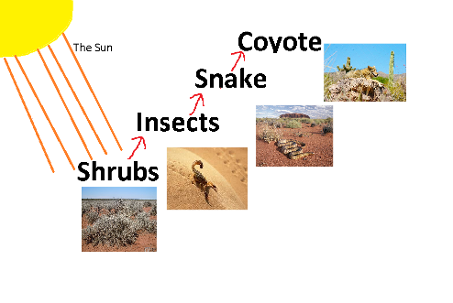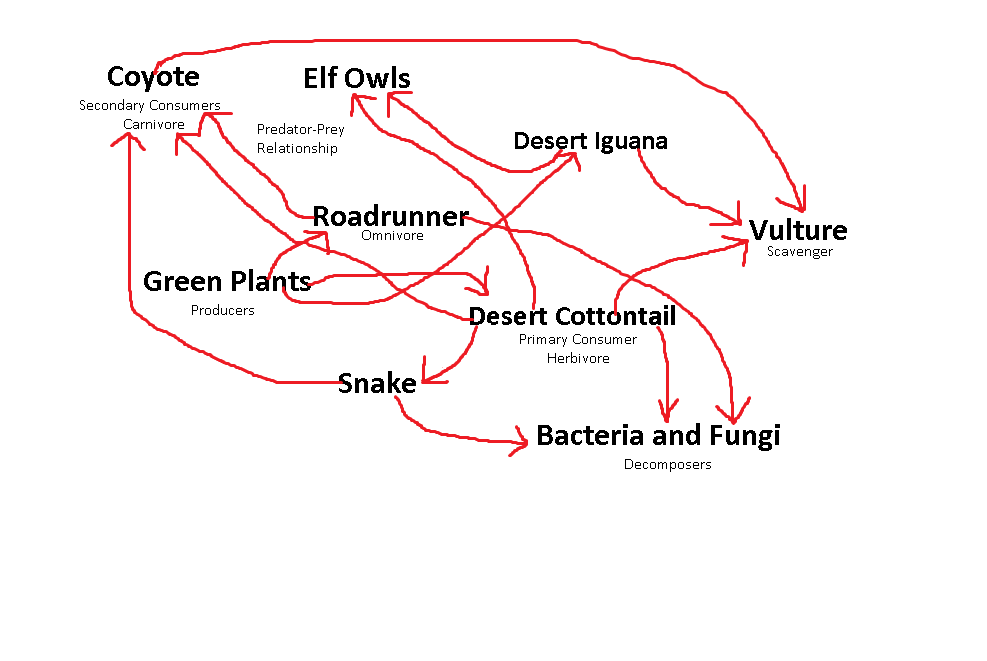Introduction to the Desert
ClimatogramA climatogram is a graph of temperatures and precipitation over the course of a year. They allow us to predict the type of biome that will exist in a given region. For example, the desert has an average temperature of 20-25 °C and an average precipitation rate of less than 50 cm. per year. Based on these abiotic factors, a climatogram would be able to predict this region was a desert and contains biotic factors such as cactus, small shrubs, reptiles, and many nocturnal mammals. The abiotic factors of a region determine what biotic factors can surivive in that region. For example, because the desert can have extreme temperatures and receives little or no rain, only animals and plants that can survive and are best suited for that type of environment will live there. These animals include scorpions, spiders, coyotes, snakes, and other organisms. Over time, scorpions and spiders have developed a thick outer covering which reduces moisture loss. This helps them maintain water in an environment that receives little precipitation, again showing how abiotic factors influence what organisms can survive and what adaptations organisms need to have to survive.
Food Chain In this food chain, the sun provides the energy for the shrubs through the process of photosynthesis. Insects are primary consumers becasue they feed on the producers. The scorpion, an insect in the desert, is an omnivore becasue it feeds on other insects and plants. The snake is a secondary consumer becasue it feeds on the primary consumer. Snakes are carnivore because they are meat eaters and only feed on small animals. The coyote is a tertiary consumer because it only feeds on secondary consumers. This completes the food chain.  Biotic factors  Abiotic factors  Energy Pyramid An energy pyramid shows how energy flows through a food chain. The different levels represent different organisms that compose a food chain; producers, primary consumers, secondary consumers, and tertiary consumers. The shape of the pyramid shows how energy that enters each level decreases as it is used by the organisms in each level. This is because even though there is a lot of energy (in the form of ATP) being taken in at each level of the pyrmaid, the energy being stored there is much less. Much of this energy consumed is lost as heat. This means the food and energy available to the next organism in the next level is far less. As you go up the pyramid, an average of 90% of energy is lost. Because there is little energy for consumers at the top of the pyramid, there is relatively few of these organisms in their habitat. As you can see in the pyramid on the left, the producers start with 100% of the energy while the coyote only receives 1%. This shows how energy decreases as you move from one level to the next in the pyramid. |
Map of Desert Biome  blueplanetbiomes.org Desert Climatogram  Food Web In the Desert biome, green plants are the producers(they get their energy from the sun.) The Desert Cottontail is the primary consumer or herbivore.(they eat plants) They feed directly on the producer. The coyote is the secondary consumer. In this case, the seconday consumer is a carnivore(only eat meat). Sometimes, the secondary consumer will feed directly on the primary consumer, and sometimes even on the producer. This means it is an omnivore(feeds on plants and meat). An example of a predator-prey relationship is between the coyote and the roadrunner. The coyote is the predator becasue it feeds on the prey, the roadrunner. If there are more coyotes than roadrunners, this leads to less of a food source for the coyotes. This leads to more competition and natural selection determines what coyotes will survive based on their adaptations to their environment. The vulture is a scavenger and feeds on the remains of dead animals. Bacteria and Fungi also deal with remains by decomposing the body to put nutrients back in the soil to help producers grow and evolve. An example of a density-independent factor is water. Even thought there is a very little of it in the desert, it is very important. Without it, many plants would die off. An example of a density-dependent factor is the roadrunner for the coyote. The coyote is dependent on the roadrunner because the roadrunner is a source of food and energy for the coyote.Without the roadrunner, competition would arise between coyotes for the next food source and many might die off. Also, invasive species can cause certain organisms to die. For example, buffelgrass is an invasive species located in the Sonoran desert. It has taken up the space of many native plants, and many plants that once had thrived are now overrun and killed by the invasive grass.  Desert Energy Pyramid  |